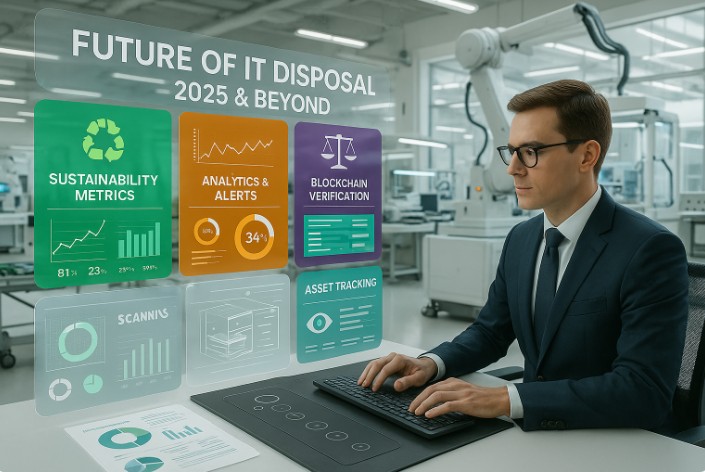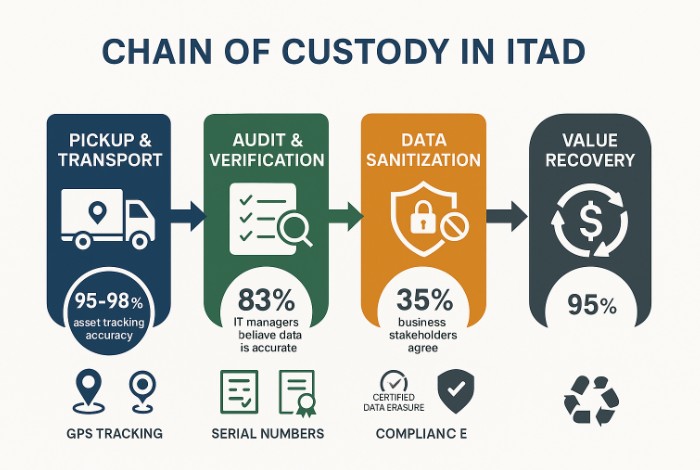In 2025, mastering IT asset recovery isn’t just good practice—it’s essential for financial efficiency and environmental responsibility. As companies face rapid technological advancements, effective management of obsolete or surplus IT assets is more critical than ever. Without a well-defined IT asset recovery strategy, businesses risk significant financial losses, compliance issues, and data breaches.
Understanding IT Asset Recovery
IT asset recovery is the systematic process of reclaiming value from obsolete or unused IT equipment. This includes servers, network equipment, laptops, and other electronic assets, typically through resale, recycling, or responsible disposal. A well-executed recovery strategy allows organizations to maximize asset value while minimizing environmental impact and legal risk.
This process plays a key role in an organization’s sustainability and cost-reduction strategies. By supporting a closed-loop lifecycle for IT equipment, businesses can extend equipment use, limit over-purchasing, and align with ESG (Environmental, Social, and Governance) goals..
Importance of IT Asset Recovery for Businesses
Proper IT asset recovery helps safeguard sensitive data, supports compliance with regulatory mandates, and reduces costs. Approximately 40% of companies lack a formal ITAD strategy, highlighting widespread vulnerabilities to data breaches and compliance violations.
Beyond compliance, asset recovery supports financial goals by improving return on investment (ROI) through resale or reuse. It also demonstrates corporate responsibility and environmental stewardship, both of which are increasingly important to customers and stakeholders.
Key benefits include:
- Stronger corporate reputation and trust
- Improved compliance with international standards
- Lower environmental liabilities
- Revenue recovery through asset remarketing and resale
Critical Components of IT Asset Recovery
Effective IT asset recovery depends on three primary components: accurate asset identification, reliable asset valuation, and responsible disposal. These processes ensure minimal waste and maximum return.
Predictive Analytics for Asset Valuation
Predictive analytics helps estimate the remaining value of IT assets, guiding informed decisions about whether to reuse, resale, or recycle. According to Transparency Market Research, the global ITAD market is projected to reach $34.6 billion by 2031, highlighting the importance of data-driven valuation.
By forecasting depreciation and market demand, businesses can maximize financial outcomes and prioritize high-value recovery paths.
Data-driven Asset Identification
Knowing exactly what assets you have—and their condition—is essential for effective recovery. Businesses that maintain up-to-date asset inventories can streamline recovery processes and reduce errors or losses.
Inventory assessment tools help detect underutilized or forgotten assets, allowing businesses to act before equipment becomes obsolete.
Blockchain for Transparent Transactions
Blockchain enhances transparency in asset recovery by creating immutable records of each transaction. This improves traceability, reduces the risk of fraud, and simplifies audits.
With increasing demand for verifiable supply chains, blockchain adoption serves as a differentiator for companies prioritizing ethical and secure IT practices.
Effective IT Asset Recovery Strategies
Developing a comprehensive asset recovery strategy involves balancing security, cost-efficiency, and environmental responsibility. Companies must stay ahead of technological changes while ensuring every phase of asset recovery meets business objectives and regulatory demands.
Overcoming Data Security Challenges
One of the biggest risks in IT asset recovery is improper data destruction. Failure to sanitize sensitive data can lead to significant breaches. Organizations should adopt certified data destruction methods and perform audits to verify compliance.
External guidelines from the National Institute of Standards and Technology (NIST) outline best practices for media sanitization.
Addressing Technological Obsolescence
Tech evolves quickly, rendering many devices obsolete in just a few years. By planning for obsolescence with lifecycle management and refresh schedules, businesses can recover maximum value while minimizing disruption.
Working with experienced vendors can help synchronize recovery efforts with obsolescence cycles and align schedules with budget forecasts.
Developing a Robust Asset Management Plan
An effective plan outlines asset tracking, valuation, and disposal or reuse. It should be revisited regularly and include roles, responsibilities, and performance metrics.
Companies can leverage internal IT teams or outsourced experts to ensure thorough planning and execution. For example, OEM Source offers comprehensive insights on secure disposal as a reputable and long-established product and service provider.
Environmental and Financial Impacts of IT Asset Disposal
Disposing of IT assets carries significant environmental and financial implications. Companies that responsibly recycle or repurpose electronics not only reduce waste but also recover a portion of their original investment.
Unfortunately, 89% of organizations recycle less than 10% of their IT hardware, resulting in unnecessary landfill waste and missed financial opportunities. To address this gap, sustainable disposal methods—such as e-waste recycling—should be a core component of any IT asset recovery strategy.
Partnering with Certified ITAD Vendors
Working with a certified IT asset disposition vendor provides confidence that your equipment is handled securely, responsibly, and in full compliance.
Certified partners typically:
- Adhere to strict data destruction protocols
- Provide Certificates of Data Destruction
- Comply with environmental standards like R2
When selecting a vendor, verify credentials, inquire about compliance procedures, and request references to ensure reliability.
Leveraging Technology for Optimized Recovery
Technology plays a vital role in modern IT asset recovery. From inventory tools to AI pricing engines, tech-driven solutions help businesses recover more value, faster.
Modern inventory management platforms offer:
- Real-time asset tracking
- Better visibility into asset conditions and locations
AI-powered platforms optimize resale by predicting demand and matching assets to buyers quickly, maximizing returns, and shortening turnaround times.
Additionally, online marketplaces such as Back Market or eBay Business have become legitimate channels for reselling refurbished enterprise equipment.
Regulatory Compliance in IT Asset Recovery
Staying compliant with data and environmental regulations is non-negotiable. Regulatory scrutiny is increasing, with severe penalties for violations.
To ensure compliance:
- Keep up with regional and international regulations like General Data Protection Regulation (GDPR)
- Maintain detailed documentation of disposal and destruction
- Partner only with vendors that meet or exceed regulatory requirements
Companies should also invest in training staff to handle IT assets securely and understand relevant compliance obligations.
Strategic IT Asset Recovery: Turning End-of-Life Equipment into Long-Term Value
Mastering IT asset recovery is key to driving long-term financial performance, safeguarding data, and meeting sustainability goals. By strategically managing IT assets, businesses can transform potential liabilities into valuable opportunities.
Proactive planning, smart use of technology, and trusted ITAD partnerships are essential for success. When done right, IT asset recovery becomes more than just an end-of-life process—it becomes a competitive advantage.
Frequently Asked Questions
What is the IT asset recovery process?
The IT asset recovery process involves identifying, evaluating, and reclaiming value from unused or end-of-life IT equipment. This includes secure data destruction, equipment refurbishment, resale, recycling, or responsible disposal. Effective recovery helps businesses reduce waste, recoup costs, and protect sensitive data.
What is the IT asset management approach?
IT asset management is a strategic approach to tracking and managing an organization’s IT assets throughout their lifecycle. This includes procurement, maintenance, auditing, and eventual disposal or recovery. A well-implemented strategy ensures optimal asset utilization, regulatory compliance, and cost savings.
What are the steps of asset recovery?
The steps typically include:
- Identifying assets and maintaining accurate inventory records
- Performing data sanitization or certified data destruction
- Assessing the condition and residual value of each asset
- Choosing between resale, donation, recycling, or disposal
- Documenting the process and generating compliance reporting
How do businesses manage IT assets?
To manage IT assets effectively:
- Maintain an up-to-date asset inventory
- Use asset management software for real-time tracking and reporting
- Establish lifecycle planning and replacement schedules
- Partner with certified ITAD providers for secure, compliant disposal
- Conduct regular audits to ensure accountability and efficiency
Why should businesses partner with certified ITAD providers?
Certified ITAD providers follow strict data security and environmental protocols. They offer verifiable destruction methods, detailed documentation, and compliance with standards like R2. Working with a certified partner helps mitigate risk, avoid penalties, and streamline the asset recovery process.





